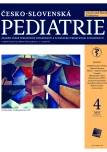Fabry disease in childhood – overview and a case report
Authors:
Munzar Petr 1; Mazurová Stella 2; Dubská Zora 3
Authors‘ workplace:
Dětská neurologie Pardubice, s. r. o.
1; Klinika pediatrie a dědičných poruch metabolismu, Všeobecná fakultní nemocnice v Praze a 1. lékařská fakulta, Univerzita Karlova, Praha
2; Oční klinika, Všeobecná fakultní nemocnice v Praze a 1. lékařská fakulta, Univerzita Karlova, Praha
3
Published in:
Čes-slov Pediat 2022; 77 (4): 219-225.
Category:
Case Report
doi:
https://doi.org/10.55095/CSPediatrie2022/036
Overview
Fabry disease is a rare lysosomal storage disorder leading to glycosphingolipid accumulation in most of tissues. Its singns and symptoms are quite distinctive, particulary in childhood. It is possible and so imperative to detect the disease at young age and start the enzyme replacement therapy to decrease the risk of late complication development in adulthood. The article offers a brief description of the disease and an illustrative case report of 12-years-old boy.
Keywords:
Fabry disease – childhood – acroparesthesia – angiokeratomas – cornea verticillata – agalsidase – ERT
Sources
1. Dutra-Clarke M, et al. Variable clinical features of patients with Fabry disease and outcome of enzyme replacement therapy. Mol Gen Met Rep 2021; 26: 1–11.
2. Poupětová H, et al. The birth prevalence of lysosomal storage disorders in the Czech Republic: comparison with data in different populations. J Inherit Metab Dis 2010; 33: 387–396.
3. Olivera-González S, Josa-Laorden C, Torralba-Cabeza, MA. The pathophysiology of Fabry disease. Rev Clin Esp 2018; 218 (1):22–27.
4. Ellaway C. Paediatric Fabry disease. Transl Pediatr 2016; 5(1): 37–42.
5. Hirashio S, Kagawa R, Tajima G, Masaki T. A classic variant of Fabry disease in a family with the M2961 late-onset variant. CEN Case Rep 2021; 10(1): 106–110.
6. Michaud M, et al. When and how to diagnose Fabry disease in clinical practice. Am J Med Sci 2020; 360(6): 641–649.
7. Aerts JM, et al. Elevated globotriaosylsphingosine is a hallmark of Fabry disease. PNAS 2008; 105(8): 2812–2817.
8. Putko BN, et al. Anderson-Fabry cardiomyopathy: prevalence, pathophysiology, diagnosis and treatment. Heart Fail Rev 2015; 20: 179–191.
9. Kok K, et al. Fabry Disease: Molecular Basis, Pathophysiology, Diagnostics and Potential Therapeutic Directions. Biomolecules 2021; 11(2): 271.
10. Rozenfeld P, Feriozzi S. Contribution of inflammatory pathways to Fabry disease pathogenesis. Molecular Genetics and Metabolism. 2017; 3(122): 19–27.
11. Germain DP, Fouilhoux A, Decramer S, et al. Consensus recommendations for diagnosis, management and treatment of Fabry disease in paediatric patients. Clin Genet. 2019; 96(2): 107–117.
12. Hewavitharana H, et al. Cornea verticillata in classical Fabry disease, first from Sri Lanka: a case report. BMC Pediatrics 2020; 20: 338–341.
13. Parini R, et al. Analysis of renal and cardiac outcomes in male participants in the Fabry outcom survey starting agalsidase alfa enzyme replacement therapy before and after 18 years of age. Drug Des Devel Ther 2020; 14: 2149–2158.
14. Špalek P. Orphan drugs v liečbe zriedkavých neuromuskulárních chorôb. Neurol Praxi 2021; 22(2): 104–112.
15. Lacina L, Kodet O, Štork J. Angiokeratom a stavy doprovázené jeho mnohočetným výskytem. Dermatol Praxi 2017; 11(3): 110–114.
16. Eng CM, et al. Fabry disease: guidelines for the evaluation and management of multi-organ system involvement. Genet Med. 2006; 8(9): 539– 48.
17. Hopkin RJ, et al. The management and treatment of children with Fabry disease: A United States-based perspective. Mol Genet Metab 2015.
18. Dubská Z, Sedláková K, Becková J, et al. Cornea verticillata a význam jejího odhalení u Fabryho choroby. Acta Medicinae 2019; 15: 77–78.
19. Tapia D, Kimonis VJ. Stroke and chronic Kidney disease in Fabry disease. J Stroke Cerebrovasc Dis. 2021; 30: 105423.
20. Ortiz A, Germain DP, Desinch RJ, et al. Fabry disease revised: management and treatment recommondations for adult patients. Mol Genet Metab 2018; 123(4): 416–427.
21. Sims K, et al. Stroke in Fabry Disease Frequently Occurs Before Diagnosis and in the Absence of Other Clinical Events. Natural History Data From the Fabry Registry. Stroke 2009; 40: 788–794.
22. Mena Rodríguez AL, et al. Histopathological findings in renal biopsies in Anderson–Fabry disease. Case series 2018; (81)4: 243–247.
23. Rekova P, et al. Fabryho choroba, přehled problematiky a nejčastější neurologické projevy. Cesk Slov Neurol N 2018; 81(2): 156–163.
24. Nowak A, et al. Fabry disease genotype, phenotype, and migalastat amenability: Insights from a national cohort. J Inherit Metab Dis 2020; 43(2): 326–333.
25. Sasa H, Nagao M, Kino K. Safety and effectiveness of enzyme replacement therapy with agalsidase alfa in patients with Fabry disease: Post-marketing surveillance in Japan. Mol Genet Metab 2019; 126(4): 448–459.
26. McCafferty, et al. “Migalastat: A Review in Fabry Disease.” Drugs 2019; (79)5: 543–554.
27. Goláň L. Migalastat v terapii Fabryho choroby. Interní Med 2017; 19(3): 167–170.
28. Sakuraba H, et al. Fabry disease in Japanese population – molecular and biochemical characteristics. Mol. Genet Metab Rep. 2018; 17: 73– 79.
29. Huges DA, Auiar P, Deegan PB, et al. Early indicators of disease progression in Fabry disease that may indicate the need for disease-specific treatment initiation: findings from the opinion-based PREDICT-FD modifies Delphi consensus initiative. BMJ Open 2020; 10.
Labels
Neonatology Paediatrics General practitioner for children and adolescentsArticle was published in
Czech-Slovak Pediatrics

2022 Issue 4
Most read in this issue
- Sepsis in children
- Differential diagnosis of microscopic hematuria
- Dystrophinopathies
- Hyperthermia, its causes and risks from the pathophysiologist’s perspective
